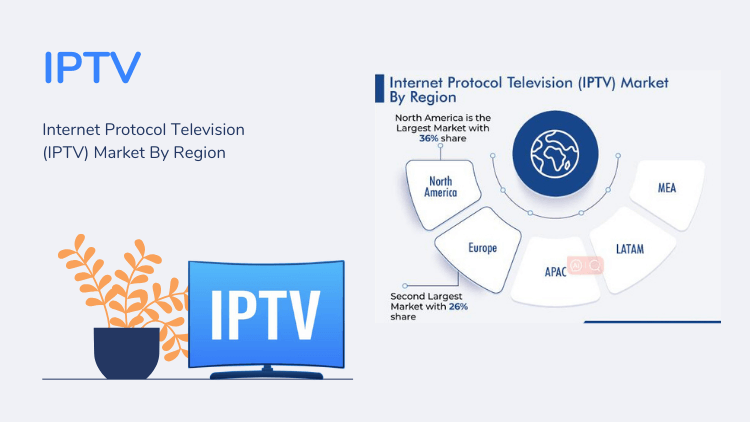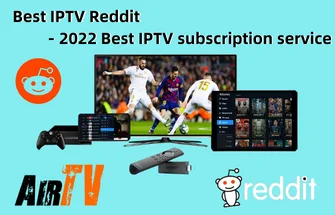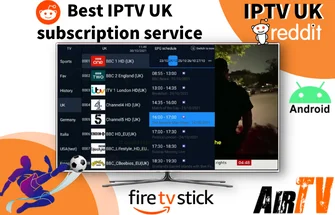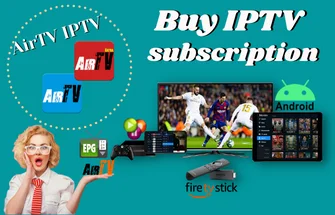When it comes to the world of streaming, the choices are abundant, but two standout contenders vie for your attention: IPTV subscription and OTT streaming. Both offer a world of entertainment, but which one delivers the ultimate streaming experience? Let’s dive into the differences and discover which option aligns with your preferences.

What is IPTV Mean?
IPTV, an acronym for “Internet Protocol Television,” signifies a revolutionary transformation in the realm of television content delivery. In contrast to the conventional modes of cable or satellite transmission, IPTV harnesses the power of Internet Protocol (IP) networks to usher TV channels and on-demand content into the lives of viewers.
One of the most remarkable attributes of IPTV lies in its robust support for multicast capabilities. This ingenious feature seamlessly accommodates multiple users, enables viewing across numerous rooms, and facilitates access through a myriad of devices, all while optimizing bandwidth utilization. This particular facet of IPTV proves especially invaluable to individuals grappling with limited Internet speeds, thereby positioning IPTV as the foremost contender to replace the traditional cable TV paradigm. To gain a deeper understanding of the inner workings of this technology, let us embark on a journey into its operational intricacies.
Read: IPTV: A new way to watch TV and Is IPTV legal.

IPTV Free Trial
- +1300 Live TV & +3000 VOD
- TV Guide (EPG)
- Plus with Catch Up & Cloud PVR
- Reliable & Stable Server
- Supported to Android & Firestick
- 3 days Free Trial, No CC
- Instant Activation
How Does IPTV Work?
IPTV introduces a transformative paradigm for the delivery of videos and television content, reimagining the process through remote server storage and on-the-fly segmentation upon user request. This streamlined operation harnesses a one-to-many distribution approach, ensuring content reaches all requesting IP addresses across the network while impeccably managing the user’s internet connection. The intricate machinery behind this process unfolds as follows:
- Content Transformation: Television signals, ranging from live channels to an extensive library of video-on-demand (VOD) content and multimedia, are meticulously transformed into data packets.
- Efficient Transmission: These data packets embark on a high-speed journey, traversing the vast expanse of the Internet or private IP networks to reach an array of user devices. These include but are not limited to set-top boxes, sophisticated smart TVs, versatile computers, nimble smartphones, and portable tablets.
- Graceful Reception and Decoding: At their final destination, the user’s device receives these data packets with finesse. Here, they undergo the complex process of decoding, gracefully unveiling themselves as vivid video visuals and crystal-clear audio components that seamlessly grace the screen and dance through the speakers.
The marvel of IPTV extends beyond its operational intricacies, as it brings a cornucopia of advantages to the viewer’s fingertips. These include unfettered access to an expansive catalog of channels, both domestic and international, an enticing array of on-demand content, and interactive features that let you pause, rewind, and even record your favorite programs (a feature offered by select IPTV services). Furthermore, IPTV grants you the liberty to indulge in your preferred content across a spectrum of devices and locations, as long as an internet connection is within your grasp.
What is OTT Streaming?
OTT, the concise abbreviation for “over-the-top,” symbolizes a paradigmatic transformation in the dissemination of video and audio content. The meteoric ascent of OTT streaming has orchestrated a dramatic shift away from traditional cable and satellite TV services, harnessing the vast power of the Internet to provide audiences with an unparalleled array of choices, accessible via a myriad of devices ranging from sleek smartphones and intuitive tablets to cutting-edge smart TVs and versatile computers.
OTT services operate on a unicast delivery model, whereby video content is individually transmitted to OTT devices or dedicated boxes. In this intricate process, each viewer forges a direct connection to the source server to indulge in their chosen content. It’s noteworthy that OTT, in contrast to IPTV, lacks the robust multicast support, a fact that can potentially strain bandwidth when multiple streams coexist on a single network. Consequently, the pivotal role played by Internet Service Providers (ISP) in optimizing and enhancing OTT transmission cannot be overstated.
The emergence of OTT streaming has catalyzed a seismic shift in how individuals consume video content, offering an unrivaled blend of choice and flexibility when juxtaposed with the rigid confines of conventional TV broadcasting. It has engendered the epoch-defining “cord-cutting” phenomenon, wherein viewers decisively sever their ties with cable or satellite TV subscriptions in favor of the liberating embrace of OTT services.
Notably, the United Kingdom assumes a preeminent position in the OTT revenue landscape within the region. OTT services, serving as the digital conduit for delivering movies and TV shows to discerning users, have obviated the need for antiquated cable or satellite subscriptions. A discerning study by Bonafide Research, aptly titled “UK OTT Market Overview 2028,” forecasts a staggering market growth of $6.7 billion by the year 2028. This meteoric surge can be attributed to the ever-expanding cohort of digital video consumers, with media and entertainment poised to retain their dominance in the OTT market share, exerting a profound influence throughout the forecasted period.
How Does OTT Work?
OTT (Over-The-Top) streaming epitomizes a pioneering approach to the direct delivery of video and audio content, circumventing the traditional realm of cable or satellite TV providers. This intricate process unfolds through the acquisition, meticulous preparation, and strategic hosting of content, orchestrated seamlessly by content delivery networks (CDNs). Users, tethered to a stable internet connection, enjoy the unbridled freedom to tap into the expansive world of OTT services, spanning a vast spectrum of devices.
Within these cutting-edge platforms, users find themselves amidst a treasure trove of content, ready to be explored at their leisure, while real-time streaming ensues with a fluidity that borders on the sublime, gracing their preferred devices with a viewing experience of unparalleled quality. While it’s true that certain OTT services may integrate advertisements or operate within the subscription model, they generously enhance the user journey with a panoply of interactive features, including but not limited to user-generated reviews and ratings. In essence, OTT streaming stands as a user-centric, internet-fueled alternative that opens the door to an extensive realm of entertainment content, effortlessly at the viewer’s fingertips.
What is the difference between OTT and IPTV?
OTT (Over-The-Top) and IPTV (Internet Protocol Television) are two distinct methodologies for delivering television and video content, each distinguished by its unique characteristics and merits. Here, we delve into the fundamental disparities between OTT and IPTV:
Delivery Mechanism:
- OTT (Over-The-Top): OTT content traverses the public internet, circumventing the traditional cable or satellite TV providers. Users gain access to OTT services through the internet on a diverse array of devices such as smartphones, tablets, smart TVs, and computers.
- IPTV (Internet Protocol Television): IPTV hinges on private IP networks for content delivery to users, frequently involving the utilization of a dedicated set-top box furnished by a particular IPTV service provider. IPTV may deploy a segregated network or dedicated infrastructure for content transmission.
Content Diversity:
- OTT: OTT services offer an expansive spectrum of content, encompassing on-demand movies, TV series, live streaming of TV channels, sporting events, news broadcasts, and original programming. Typically, users enjoy immediate access and possess the autonomy to select their viewing preferences.
- IPTV: IPTV predominantly emphasizes live TV channels, providing a more conventional television experience. While certain IPTV services may incorporate on-demand content, their primary forte lies in disseminating live television channels via IP networks.
Payment Models:
- OTT: Numerous OTT services operate on a subscription-based model, where users remit a monthly fee for content access. Some may also proffer free, ad-supported content or a hybrid approach that combines both payment models.
- IPTV: IPTV services frequently necessitate users to subscribe to a specific service provider, who often bundles TV channels into packages. Users typically incur a monthly subscription fee for channel access.
Subscription Costs:
- OTT: Many OTT services offer a free tier, granting access to most content. Paid subscription costs are generally affordable, hovering around $10 per month.
- IPTV: IPTV services, owing to their extensive channel options, tend to command a higher price point, typically falling in the $15 to $30 per month range.
Device Compatibility:
- OTT: OTT services exhibit broad compatibility, supporting an array of devices such as smart TVs, streaming media players (e.g., Roku, Apple TV), smartphones, tablets, and computers. Users can access OTT content via dedicated apps or web browsers.
- IPTV: IPTV services frequently mandate the use of a dedicated set-top box or device provided by the service provider. While some IPTV services offer apps for various platforms, the primary viewing experience often relies on the provided hardware.
Flexibility and Portability:
- OTT: OTT services offer greater flexibility and portability, permitting users to indulge in content on multiple devices and from diverse locations, contingent upon an internet connection.
- IPTV: IPTV services may impose constraints regarding device compatibility and portability, as they frequently hinge on proprietary set-top boxes.
Additional Features:
- OTT: With an internet connection, users can download OTT apps and stream their favorite shows on dozens of devices, anytime, anywhere, including the ability to download and watch content offline.
- IPTV: IPTV, conversely, is typically confined to devices within the home, as the service operates within a closed network and necessitates a connection to its set-top box and router.
Service Reach:
- OTT: Boasting a global reach, OTT services offer a user-friendly registration process akin to creating an online account, granting immediate access to live streaming.
- IPTV: IPTV services are typically provided by local Internet service providers, limiting their reach to specific geographic regions or service areas.
IPTV VS OTT, main advantages and disadvantages
When juxtaposing OTT (Over-The-Top) and IPTV (Internet Protocol Television), we encounter a fascinating array of advantages and disadvantages unique to each. IPTV services wield the formidable advantage of dedicated allocation, a meticulously managed resource under the stewardship of telecom operators. This pivotal facet endows it with unparalleled stability during streaming, virtually eliminating the specter of interruptions that occasionally haunt OTT experiences. Furthermore, broadband network signals often carve out their own reserved lanes for streaming media, bolstering the reliability of IPTV. However, it’s worth noting that to partake in the IPTV experience, the possession of a decoding box is requisite. Nevertheless, IPTV shines brightly with its support for multicast mode, enabling efficient content delivery to multiple users simultaneously.
In contrast, the allure of OTT video streaming services lies in their accessibility through the public internet, casting a wide net that welcomes anyone with an internet connection. This accessibility comes hand-in-hand with a cost-effective and user-friendly pricing structure, a hallmark of OTT’s appeal. The simplicity of installation further burnishes its reputation as a convenient choice. However, OTT’s Achilles’ heel is its reliance on unicast mode, tethering the viewer’s experience to the capricious speed of their internet connection. This vulnerability is encapsulated in the buffering dilemma, where the flow of content can be abruptly halted, plunging viewers into the frustrating abyss of interrupted viewing.
In summary, here is a table elucidating the distinctive advantages and disadvantages of both OTT and IPTV:
| Aspect | OTT (Over-The-Top) | IPTV (Internet Protocol Television) |
|---|---|---|
| Network Allocation | Public Internet Connection | Dedicated and Managed by Telecom Operators |
| Stability During Streaming | Prone to Interruptions Due to Internet Speed | Virtually Interruption-Free Due to Dedicated Allocation |
| Broadband Signal Reserved | Not Typically Reserved for Streaming Media | Often Reserved for Streaming Media |
| Additional Equipment | Simple Installation, No Additional Hardware | Requires a Decoding Box |
| Streaming Mode | Unicast | Supports Multicast Mode |
| Accessibility | Accessible to Anyone with Internet Connection | Availability Limited to Specific Service Areas |
| Cost and Pricing | Cost-Effective and User-Friendly Pricing | May Have Higher Costs Depending on Service Provider |
| Installation Complexity | User-Friendly and Easy | Generally Requires Additional Hardware Setup |
| Buffering Issues | Prone to Buffering and Interruptions | Minimal Buffering, Reliable Streaming Experience |
Advantages of OTT:
- Low cost
- Diverse programming
- Minimal or no installation required
Disadvantages of OTT:
- The quality of the streaming depends on the Internet speed
- You can’t watch cable channels, you can only watch shows or movies
- Some ISPs enforce data caps on data bandwidth
Advantages of IPTV:
- High-quality video with fewer interruptions
- No special installation required, just a set-top box
- On-demand view and get display release dates
- Featured channel pack subscription packages
- Many functional service options
Disadvantages of IPTV:
- Sold as a subscription-based package
- Internet speed affects streaming quality
- Requires the device to be connected to a private network
These factors present viewers with a diverse array of choices, allowing them to make informed decisions based on their priorities and preferences in the realm of video content consumption.
Is IPTV or OTT better?
In the discourse presented earlier, a comprehensive analysis of both OTT and IPTV has been articulated, delineating their comparative strengths and weaknesses. While these two approaches possess distinctive attributes, it is essential to underscore that OTT often assumes a dominant role across multiple dimensions. Nevertheless, it is crucial to acknowledge that IPTV boasts its own formidable strengths, particularly concerning control, content quality, and a plethora of versatile functionalities.
Over the last two years, we have borne witness to the astounding expansion of the global IPTV market, achieving a remarkable scale of $30.134 billion in market size. Remarkably, IPTV has entrenched itself with a substantial 26% market share in European nations. This meteoric surge owes its momentum to several pivotal factors, including the exponential growth in high-volume subscriptions, the early adoption of IPTV technology, widespread acceptance, and an ever-increasing appetite for Video-on-Demand (VOD) services and related package offerings.
Consequently, IPTV finds itself progressively gaining ground among discerning users. This upward trajectory exhibits unwavering resilience, positioning IPTV as an increasingly compelling alternative to the omnipresent OTT. In the foreseeable horizon, IPTV emerges as the quintessential choice for many seeking an unparalleled streaming experience, firmly establishing itself as the harbinger of a new era in content consumption.

Which is more popular in the UK, IPTV or OTT?
The United Kingdom has witnessed a significant surge in the adoption of both IPTV and OTT services, and this upward trajectory is projected to persist throughout the year 2021. Nonetheless, it’s imperative to acknowledge that the allure of these services can exhibit variations contingent upon distinct demographics and geographical regions.
IPTV, in essence, denotes television services delivered via the Internet, often channeled through dedicated set-top boxes or specialized applications tendered by designated IPTV service providers. The purview of these services encompasses a comprehensive spectrum, spanning traditional cable or satellite TV channels to an enticing array of on-demand content offerings.
In stark contrast, OTT services constitute an expansive and diverse cohort of streaming platforms that seamlessly ferry content over the internet, obviating the necessity for conventional cable or satellite subscriptions. This category encompasses renowned services such as Netflix, Amazon Prime Video, Disney+, and a panoply of others.
The predilection for either IPTV or OTT services hinges on a multifaceted tapestry of factors. These encompass individual preferences, the accessibility of high-speed internet infrastructure, considerations regarding pricing structures, and the breadth of content offerings. Within the United Kingdom, an eclectic landscape of viewers may gravitate towards IPTV for its semblance to traditional channel lineups, while others might be drawn to OTT services in pursuit of the expansive reservoirs of on-demand content and captivating original programming.
To ascertain the current landscape of popularity for IPTV and OTT services within the United Kingdom, it is prudent to embark on comprehensive market research endeavors. The dynamics within the media and entertainment industry remain in perpetual flux, with IPTV services, in particular, attaining prominence, often propelled by the fervor for live sports events that are cherished in the UK. The recognition of its convenience and the discernible trends augurs well for the future of IPTV, cementing its status as a formidable contender in the ever-evolving arena of digital entertainment.
Future development trends of IPTV
The global IPTV market has experienced a profound transformation catalyzed by the COVID-19 pandemic. Illuminating insights from Market Insights indicate that the market’s dimensions have undergone a remarkable surge, escalating to an impressive $59.68 billion by the year 2022. This upward trajectory shows no signs of abating, with projections pointing towards sustained expansion, expected to reach an impressive $68.78 billion in 2023 and ultimately culminating in a substantial $211.32 billion by the year 2030.
Across the continent of Europe, including the vibrant landscape of the United Kingdom, IPTV services have met this escalating demand with an expansive and captivating repertoire of content offerings. These encompass a captivating mosaic of local, regional, and international channels, intertwined with a rich tapestry of on-demand content. The intrinsic allure of multilingual and multi-channel accessibility harmonizes seamlessly with Europe’s eclectic demographic, affording viewers the privilege of tailoring their content consumption according to their nuanced preferences. This inherent flexibility seamlessly extends to on-demand viewing, conferring upon users the power to engage with their preferred content at their leisure, irrespective of geographical confines.
The hallmark of IPTV’s appeal has often been its convenience, magnanimously celebrated for its subscription model, which bestows upon users the keys to an expansive content library in exchange for a fixed, easily manageable monthly fee. This inherent adaptability has orchestrated a seismic shift in the television landscape, effectively steering viewers away from the shackles of traditional TV towards the liberating embrace of Internet-based services. This transformative shift in consumption patterns underpins the remarkable and steadfast growth trajectory of the IPTV market. Consequently, when juxtaposed with OTT, IPTV emerges as a beacon of promise, poised for a trajectory of sustained and impressive development in the foreseeable future.
Relevant Article: Is IPTV legal in Australia
FAQ
Is streaming TV the same as OTT?
Streaming TV and OTT (Over-The-Top) are interrelated concepts, yet they maintain nuanced distinctions.
Streaming TV denotes the practice of real-time television content consumption via internet connectivity. This encompasses the seamless transmission of live TV channels, sports events, news broadcasts, and an array of other programming over an internet connection. Multiple delivery methods facilitate streaming TV, spanning IPTV (Internet Protocol Television), streaming applications offered by cable TV providers, and even conventional broadcasters extending online streaming options.
In contrast, OTT (Over-The-Top) stands as a more comprehensive term, enveloping the conveyance of diverse multimedia content. This expansive spectrum includes television shows, films, original programming, and a plethora of other offerings, all disseminated over the Internet. OTT services are renowned for their on-demand content accessibility, affording viewers the liberty to indulge in their chosen content at their convenience. It’s crucial to recognize that while streaming TV nestles within the confines of OTT, OTT services extend their reach beyond live TV channels, incorporating a cornucopia of content originating from various sources.
To encapsulate, streaming TV is a specialized term that pertains specifically to the real-time transmission of television content via the Internet. In contrast, OTT serves as a broader umbrella, encompassing a myriad of content delivery methods, encompassing live TV channels as well as an extensive array of on-demand content.
Is Netflix IPTV or OTT?
Netflix is classified as an OTT (Over-The-Top) platform due to its direct delivery of video content to users via the Internet, effectively circumventing the need for conventional cable or satellite TV providers. Such widely embraced streaming services serve as quintessential embodiments of the OTT paradigm, providing a diverse array of content to a worldwide audience.
What is an example of IPTV?
There are many examples of IPTV, there are free IPTV and paid IPTV. Free IPTV ads are many and unstable, while paid IPTV is what users seek. It includes AirTV IPTV, IviewTV, OTV IPTV, XtrixTV IPTV, IviewHD IPTV, Typhoon Labs IPTV, Kind IPTV, Yeah IPTV…
Is streaming TV OTT?
OTT, which stands for Over-the-Top, denotes content providers that dispatch media content directly to users via the Internet, eschewing the requirement for conventional cable or satellite TV services. Conversely, streaming is the all-encompassing technology employed for the real-time transmission of data, spanning audio, video, and more, over the internet. In essence, OTT platforms harness the prowess of streaming technology to furnish content to users.
What are the OTT Media services?
There are many OTT platforms that offer OTT media services. including Netflix, Disney+, Hulu, HBO Max, Amazon Prime Video, Peacock, CuriosityStream, Pluto TV, and more.
Is IPTV legal in UK?
Within the United Kingdom, IPTV is deemed legal, provided that the content being streamed adheres to copyright laws and does not involve piracy. To operate within the bounds of the law, service providers must secure the requisite licenses from content creators, thereby ensuring the legal legitimacy of their streaming services.
Is IPTV worth it the UK?
IPTV services present the notable advantage of providing markedly superior stream quality in comparison to conventional delivery methods. They remain unhindered by limitations like bandwidth constraints and cost-related barriers, factors that frequently curtail access to numerous live TV channels, given their expensive subscription prerequisites.
Final thoughts
In the quest for the ultimate streaming experience, the choice between IPTV and OTT is a matter of personal preference. While IPTV subscription ensures a stable connection and a vast channel lineup, OTT offers flexibility and a wealth of on-demand content. To make an informed decision, consider trying an IPTV Free Trial and explore the world of streaming firsthand. The ideal streaming experience awaits, tailored to your unique tastes and needs.




